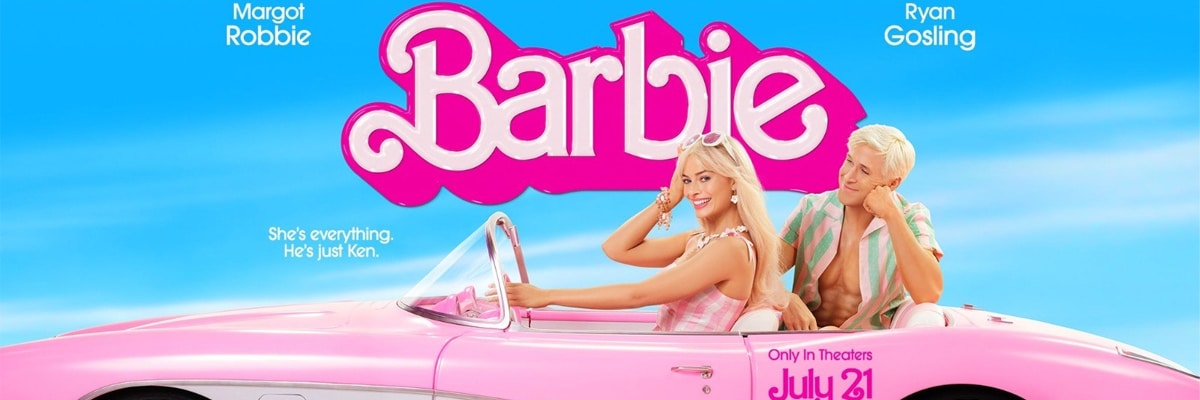Half serious
Unless you have been abducted by aliens, you have certainly heard in the past few months about the Barbie movie. This is the first live action film inspired by the popular doll produced in 1959 by Mattel, a U.S. company that collaborated on the movie production, intertwining both corporate and content-wise with the product. Independent director Greta Gerwig's feature film opens with Hellen Mirren's voiceover narrating the story of the popular U.S. doll, introducing the development of the tale.
In a perfect pink world called Barbieland, perfect plastic dolls live a set of perfect days, between perfect "women-only" parties and perfect seaside hikes. In an eternal return of equals there is no place for suffering and hiccups, the male dolls are just extras, living by the reflected light of stereotypical Barbie, played by the luminous Margot Robbie. The quiet life is interrupted by thoughts about death that lead the protagonist to break through to the real world - a reference to a well-known cinematic topos seen in "The Matrix," "Truman Show" and "Pleasantville" - where feelings and conflicts between genders exist. Barbie and Ken thus go into the real world and each has an epiphany, a mirror-image insight on which to build a different society. The simple-minded Ken, played by the brilliant Ryan Gosling, will become convinced that he wants to carry the baggage of the "patriarchy," seen essentially simplistically and grotesquely as a world of "horses and beers"; Barbie will discover that beyond a perfect body there’s more and will try to convince the other dolls to take back Barbieland and be themselves without the perfectness in which plastic forces them. The result will be a parody struggle between men and women, between amazonism and farce, in which Barbie will win and the protagonist will decide to step out of the toy box and become flesh and blood.
Beyond the plot, unsuitable to hold a full-length film, the movie unravels between grotesque sketches, parts of musicals and metamessages. The audience always has the doubt that the director wants to dance in the balance between feminist critique and parody, the film run with the hare of capitalism and hunt with the hounds of female empowerment, Barbie is entitled to be played by the beautiful and perfect Margot Robbie, to have a world of pink dresses and simultaneously to self-determination. In addition to being a product of progressive ideology, the film is a gargantuan rebranding effort by Mattel, which years ago was already thinking about how to reposition its target market, winking at the pinkwashing of the "Instagram generation" and creating a niche for itself in grown-up collectionism.
The symbolic violence
The concept of symbolic violence was introduced by sociologist Bourdieu to denote a type of influence of the ruling classes - now we would say mainstream - who accomplish cultural hegemony without apparent constraints but through symbols. The movie surfs over the tsunamis of this unfortunate era, disguising the battle with pink glitter. In the film's opening scene, some little girls bash baby dolls, a symbol of women's revolt against gender roles, reinforcing the denial of motherhood in a country like ours where the birth rate is at its lowest. In addition to the blonde Barbie Margot Robbie, other dolls appear in the film, one of them being Midge, the Barbie with a baby bump -really put on the market in 1963 - who is described by the protagonist as a somewhat useless character on the fringes, because after all, motherhood is not cool, it is not a thinkable and thought out role in the world where one can be what one seems with imagination, except mothers.
Generation Z has as its spokeswoman a young teenager, the daughter of one of Mattel's designers, who rejects Barbies as useless and reactionary toys, apostrophizing the pre-conversion Barbie "fascist," an epithet that for Americans is the umbrella concept for anything not cloaked in woke culture. Lastly, Margot Robbie speaking of her perfect plastic abode says that "this is Barbie's dream house, not Ken's dream house," expressing a symbolic concept of a society theorized for women by women, but also bringing to mind the plight of separated fathers, many of whom, according to Eurispes data, have no home at all.
The construction of respect and difference
Barbie is a film that exalts the contradictions of recent decades, glamorizing with satire the truth of the relationship between the genders; the Ken men are accessories, even when they fight at the end of the film the impression is not of manhood but of awkward dancing. The impression is that the film promotes great, great loneliness as the only successful model of life. An extreme loneliness that aims to engulf any sentimental relationship for the sake of a greater good: fighting patriarchy. To fight patriarchy, men must be tricked into considering them little more than decorative trappings. It would have been nice if in the last scene the two protagonists learned to find their own way, hand in hand, helping each other and respecting each other's sensitivities and differences, then yes, it would have been a transgressive film.
A graduate in Psychology, a political activist, she cultivates in parallel a passion for the topics of political communication, the relationship between the sexes and military history.









Stima per questa ragazza, non ho visto il film, ma sono certo che la recensione sia corretta, il film già dal trailer si vede che è una robaccia tossica che dipinge noi uomini come il Male assoluto e sono saturo di sta storia, e mi fa piacere che una donna sottolinei quanto questa nuova corrente di pensiero sia sbagliata e dannosa.